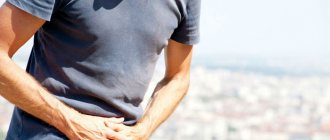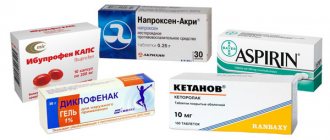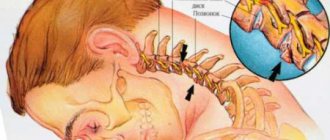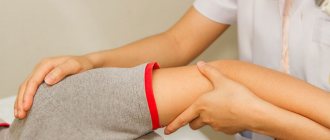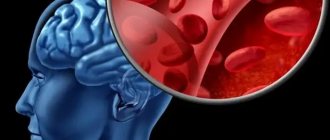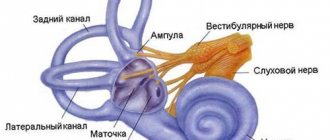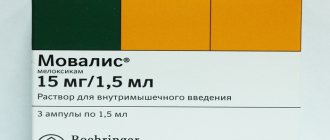Injections for a pinched nerve in the lower back are prescribed to relieve pain, reduce inflammation and relax spasmodic muscle fibers. Depending on the location of the lesion, the stage of the disease and the nature of the muscle spasm, a set of drugs is individually selected.
The advantage of the injection method of administering the medicine is that the healing substances act directly on the site of inflammation and reach it within 5–10 minutes. There is no nausea, heartburn or bitterness in the mouth that occurs when taking pills.
What is it: first signs and symptoms
The key sign of a pinched nerve is sharp pain, the localization of which depends on the location of the damaged segment of the spine. When the cervical spine is affected, the pain syndrome spreads to the upper limbs. Burning, tingling and loss of skin sensitivity indicate the development of neurological symptoms due to compression on the cervical nerve. In addition, the patient complains of headache, nausea, dizziness and limited neck mobility.
Chest compression is similar to symptoms of a heart attack.
Pain appears between the shoulder blades and spreads along the ribs to the sternum. The patient experiences a feeling of “running goosebumps” on the chest, upper back and abdomen. If after taking a Nitroglycerin tablet the pain does not go away, then this is pinching.

A pinched nerve in the chest can feel like a heart attack
Sometimes the pain radiates to the side, the stomach area, causing unpleasant discomfort in the digestive tract. Taking into account nonspecific symptoms, a differential diagnosis of pinching with intercostal neuralgia or an attack of pancreatitis or renal colic is carried out.
A pinched nerve in the lower back is accompanied by a nagging pain that spreads to one or both lower limbs, loss of sensation, and lower back pain. With this localization, diseases of the pelvic and digestive organs are excluded. In women, gynecological diseases may be to blame.
If a pinched sciatic nerve is diagnosed, a characteristic clinical picture develops:
- severe pain in the back, buttocks, back of the thigh, reaching to the toes;
- burning and difficulty moving the lower limb on the affected side.
- support on the affected leg is difficult, gait is impaired. The pain increases during movement or standing still for a long time.
Preventive actions
To prevent a pinched nerve from happening to you, you can protect yourself from it with timely prevention. Preventive measures include the following.
- Avoid hypothermia. Do not be in a draft, wear appropriate clothing if it is cold outside, and do not stay in cool rooms.
Getting rid of extra pounds is a big step in preventing pinched nerves. This will also help improve your overall health and reduce the risk of many diseases. Also, if there are problems with posture, even minor ones, it is necessary to correct it. And if you are over thirty, you need to be examined by a neurologist once a year.
What to do: first aid
Acute back pain is a condition that requires emergency treatment with potent analgesics. If the patient does not have the opportunity to urgently contact a medical specialist, the following actions are carried out as part of pre-medical care:
- The victim is placed on a flat, hard surface with a small cushion placed at the waist.
- In case of severe pain, you can take an analgesic - Baralgin, Tempalgin, Analgin.
- Wearing a rigid orthopedic corset or tight bandaging with a wide elastic bandage to create therapeutic compression will help reduce the pain symptom.
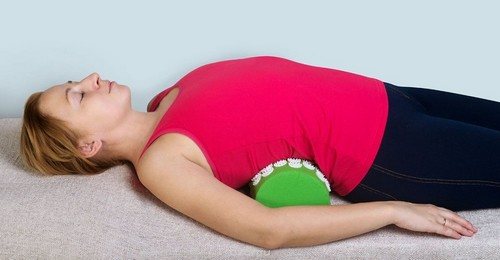
It is not recommended to use ointments and gels with a warming effect. Nerve pinching is often accompanied by inflammation, and warming procedures can dramatically worsen the condition and lead to undesirable consequences.
The patient should be taken to a doctor as quickly as possible to determine the cause of the pathological effect on the nerve fibers.
What is nerve compression in the spine?
Pathology occurs due to compression of certain nerve endings. In 35%, this condition is caused by muscle spasm, hernia or protrusion of the intervertebral disc. It is impossible not to notice the disease, since the patient feels sharp, unbearable pain in the pinched area and limited motor activity.
Most often, pathology is observed in the cervical and lumbar region. It occurs closer to the age of 40 in both women and men. Many people treat this disease themselves using traditional methods, which is not effective.
As a result, concomitant diseases appear and health is seriously undermined. Such pathologies should be treated only under the supervision of a qualified specialist.
Causes - what causes pinching
With age, gradual tissue destructuring (osteochondrosis) develops in the spine. The first to undergo dystrophy is the cartilaginous disc, which is located between the vertebrae. The fibrous membrane located at the edges softens, and the nucleus pulposus from the center rushes to the weak spot with the formation of a pathological protrusion. As a result, the herniated disc puts pressure on the nerve root, leading to a pinched nerve in the spine.
Other causes of the disease include:
- poor posture - scoliosis, increased thoracic kyphosis, cervical or lumbar lordosis;
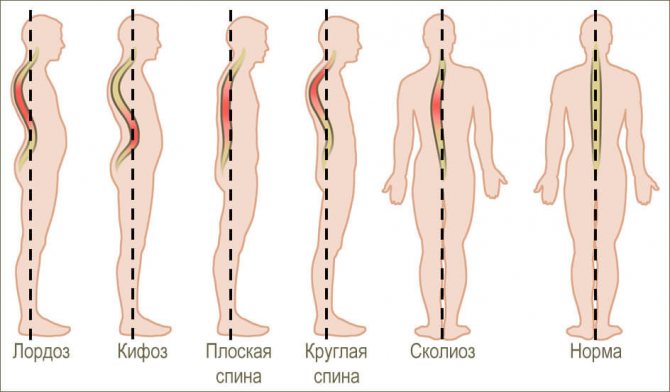
Any poor posture can cause a pinched nerve. - spinal injury;
- osteophytes (bone growths);
- spondylolisthesis – slipping of the vertebrae relative to each other;
- tumors of a benign or malignant nature.
The impetus for the development of pathology can be:
- sudden lifting of weights;
- hypothermia;
- intense physical activity;
- sudden movement to the side;
- hormonal disbalance;
- disruption of the endocrine glands;
- static tension in an unusual position.
In rare cases, pinching in the spine is diagnosed in childhood. Most often, pathology can occur after intense physical activity in a child with an underdeveloped back muscle frame. In infants, neurological disorders can develop as a result of birth trauma.
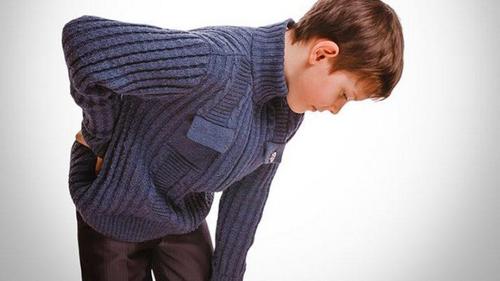
Pinched nerves are rare in children.
Risk factors for pinched nerves
The following factors may increase your risk of getting a pinched nerve:
- Floor. Women are more likely to develop carpal tunnel syndrome, possibly due to the small size of the carpal tunnel.
- Bone spurs. An injury or disease that causes thickening of the bones, such as osteoarthritis, can cause bone spurs. Bone spurs can stiffen the spine and also narrow the space through which nerves pass, pinching nerves.
- Rheumatoid arthritis. Inflammation caused by rheumatoid arthritis can compress nerves, especially in the joints.
- Thyroid disease. People with thyroid disease are at higher risk of carpal tunnel syndrome.
Other risk factors include:
- Diabetes. People with diabetes are at higher risk of nerve compression.
- Excessive use. Jobs or hobbies that require repetitive movements of the arms, wrists, or shoulders, such as working on an assembly line, increase the likelihood of a pinched nerve.
- Obesity. Being overweight can put more pressure on your nerves.
- Pregnancy. Increases in body water and weight associated with pregnancy can cause nerve pathways to swell, compressing nerves. Prolonged bed rest. Long periods of lying down can increase the risk of nerve compression (squeezing).
Which doctor to see, diagnosis, how long it takes
Treatment and diagnosis of pinching should be carried out by a qualified doctor.
If signs of root compression appear, it is recommended to contact a neurologist and vertebrologist who specializes in back diseases and will tell you how to recognize pinching, whether there may be a fever and how to quickly cure the pathology.
During the examination, you may additionally need consultations with an endocrinologist, gastroenterologist and cardiologist.
The main goal of conducting an accurate diagnosis is to determine why the nerve in the back is pinched. The tactics of effective treatment depend on the etiological factor. To do this, the patient is sent to undergo a hardware examination:
- radiography;
- magnetic resonance imaging;
- electroneuromyography;
- computed tomography.
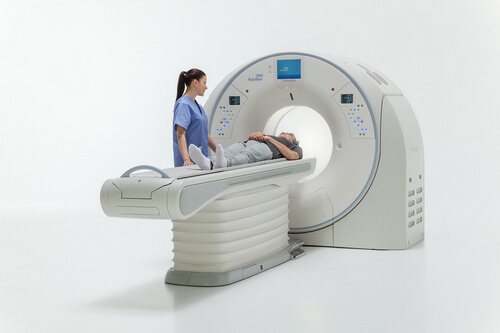
A laboratory blood test is prescribed to assess the general condition. To exclude oncological diseases, a biopsy is performed, as well as an electrocardiogram if disorders of the cardiovascular system are suspected. Based on the results of a comprehensive examination, the doctor chooses a treatment method, the goal of which is to return the person to their normal lifestyle as quickly as possible.
It is impossible to say with accuracy how much the back hurts when a nerve is pinched. The speed of recovery depends on the cause of the disease and individual parameters. Mild forms of pinching go away in 2-3 days without special treatment, and when complicated by inflammation of the sciatic nerve, it takes 3 weeks or more.
Good article to follow up:
Which doctor treats the spine? TOP 15 doctors who treat the neck, lower back and back
Diagnosis of the causes of pain between the shoulder blades
If you experience pain between the shoulder blades, you first need to make an appointment with a neurologist. First of all, the doctor will interview the patient, find out what worries him most, what other symptoms he observes, clarify the nature of the pain, features of work and lifestyle. After this, he conducts an examination, palpating the spine, performing neurological tests, etc. The data obtained as a result of the survey and examination allows the specialist to assume what exactly caused the pain between the shoulder blades, and to prescribe additional studies to clarify the type of pathology, stage of development and general assessment spinal conditions.
Therefore, patients are prescribed:
- X-ray;
- CT;
- MRI.
They always try to give preference to MRI, since it is this method that allows you to obtain the most accurate and complete data on the condition of all vertebral structures, and assess the condition of the spinal cord and its roots. Using MRI, it is possible to identify not only intervertebral hernias and accurately determine their size, but also to diagnose protrusions with a size of 1-2 mm. Moreover, the method is absolutely safe and can even be used for examining pregnant women.
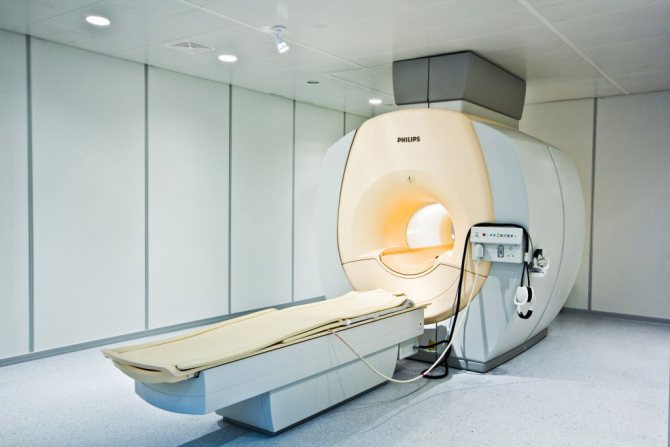
In our clinic, you can also learn in more detail about the composition of your body and the state of the vascular system, which is involved in the blood supply to internal organs, skeletal muscles, and the brain. Our experienced doctors will explain the data obtained to you in detail. Bioimpendansometry calculates the ratio of fat, muscle, bone and skeletal mass, total fluid in the body, and basal metabolic rate. The intensity of recommended physical activity depends on the state of muscle mass. Metabolic processes, in turn, affect the body's ability to recover. Based on the indicators of active cell mass, one can judge the level of physical activity and nutritional balance. This simple and quick test helps us identify disturbances in the endocrine system and take the necessary measures. In addition, it is also very important for us to know the condition of blood vessels for the prevention of diseases such as heart attacks, hypertension, heart failure, diabetes and much more. Angioscan allows you to determine such important indicators as the biological age of blood vessels, their stiffness, stress index (which indicates heart rate), and blood oxygen saturation. Such screening will be useful for men and women over 30, athletes, those undergoing long-term and severe treatment, as well as everyone who monitors their health.
If signs of diseases of the heart, gastrointestinal tract and respiratory system are detected, the patient is referred for consultation to a cardiologist, gastroenterologist or pulmonologist. These specialized specialists will help eliminate existing diseases of the internal organs, but their intervention in therapy does not eliminate the need to treat spinal pathologies that have created the preconditions for the development of disorders in the functioning of the internal organs.
Painkillers
The first stage of treatment for a pinched root is to relieve the pain attack. How to relieve pain becomes clear after determining the cause and studying the clinical signs, since symptoms and treatment are closely interrelated.
To eliminate pain, analgesics are prescribed in different forms. In this case, the patient is prescribed bed rest and the exclusion of any physical activity. In addition, it is recommended to adhere to a special diet excluding salt and hot spices.
Pills
For mild to moderate pain, anesthetics are prescribed in tablet form:
- Nonsteroidal anti-inflammatory drugs help not only get rid of pain, but also eliminate inflammation - Next (Ibuprofen), Ketorol (Ketorolac).
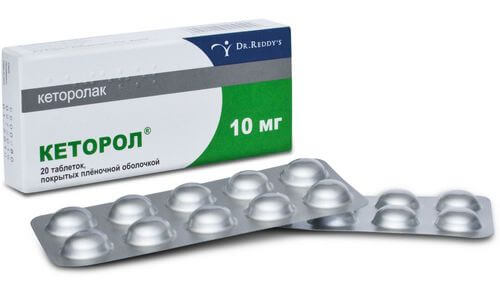
Ketorol is a strong remedy for severe pain - Muscle relaxants to reduce muscle spasms - Mydocalm (analogue - Tolperisone), Sirdalud (analog - Tizanil).
- Antispasmodic drugs relax muscles, relieving pain - No-Shpa (analogue - Drotaverine).
- Analgesics – Pentalgin, Sedalgin.
- Narcotic analgesics for intense pain syndrome - Tramadol, Tramal.
How to treat a pinched nerve in a child’s back? To relieve acute back pain in a child, painkiller suspensions are produced - Nurofen (Ibuprofen). The doctor determines the drug dosage regimen and prescribes how to treat a pinched nerve in the child’s back.
Injections
Injection solutions injected into a muscle or vein quickly have a therapeutic effect. Therefore, to eliminate severe pain, the following course is prescribed:
- NSAIDs – Movalis (analogue – Amelotex), Diclofenac, Ortofen, Voltaren, Artrosan, Meloxicam;
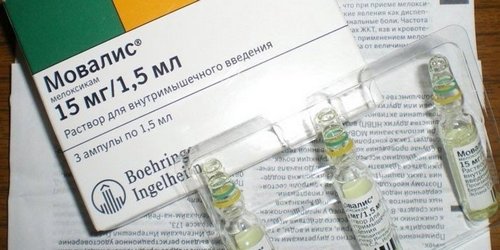
Movalis - an effective injection for pinched nerves - B vitamins – Milgamma (analogue – Kombilipen);
- Glucocorticosteroids in the absence of effect from non-hormonal anti-inflammatory drugs - Prednisolone, Dexamethasone.
In addition, in case of unbearable pain, a local blockade with analgesics - Novocaine, Lidocaine - is prescribed.
Be sure to read this good article:
Pinched nerve in the lower back: 10 treatment methods, ointments, injections and tablets, gymnastics, how to treat at home
Ointments and gels
To eliminate mild pain, bruises, and inflammatory reactions, local medications are applied to the sore spot. Ointments and gels help cope with pain and help remove excess fluid, which helps remove swelling. It should be remembered that with the wide variety and availability of local remedies, they should be prescribed by a doctor. Self-medication can lead to secondary complications.
For nerve pinching, the best help is:
- Voltaren emulgel;
- Finalgon;
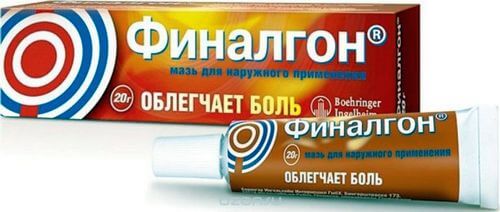
Finalgon - strong warming ointment - Bystrumgel;
- Nise gel;
- Dolobene;
- Capsicam;
- Viprosal.
To restore cartilage tissue, agents with a chondroprotective effect are prescribed - Honda cream, Chondroxide. The consequences of subcutaneous hemorrhages are eliminated by Lyoton, Troxevasin, Troxerutin.
Plasters
The most convenient method of pain relief among local remedies is patches. You just need to stick them on the affected area, after degreasing the skin, and wait for the therapeutic effect. The most effective patches for pinched nerves in the back:
Versatis . This is a patch containing lidocaine (a local anesthetic). The product fights inflammation more than pain. Versatis is effective for 12 hours, the course of treatment is 5 days. Price – from 850 rub.
Voltaren . The product contains a non-steroidal anti-inflammatory substance – diclofenac sodium. The patch relieves inflammation and minor pain. The product is valid for 24 hours. The course of treatment is 10-14 days. Price from 250 rub.
How to treat: drug therapy
The goal of treatment for pinched lumbar nerve is to eliminate pain and restore the patient’s body. In most clinical cases, medication treatment is effective in treating nerve compression in the lower back.
4-6 weeks after the start of treatment, high positive results can be achieved.
Pills
The easiest way to relieve pinching is to take a pain reliever. Typically, a simple analgesic or a strong non-steroidal anti-inflammatory drug can be taken in combination with a muscle relaxant. For example, Analgin is suitable for analgesics, and NSAIDs + muscle relaxant: Ketorolac and Sirdalud. The medications must be prescribed by a doctor.
Painkiller injections
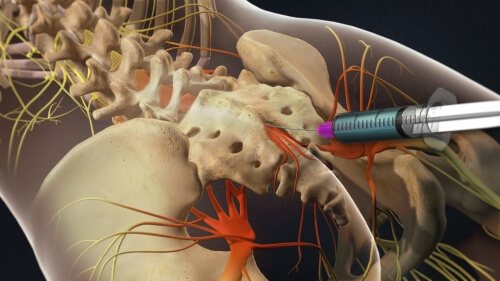
When relieving pain with injections, the effect occurs much faster, but with a less pronounced negative effect on the stomach, unlike tablets. The most popular injections are NSAIDs (Diclofenac, Ortofen, Ketonal) and muscle relaxants (Mydocalm).
Additionally, injections of B vitamins are prescribed to improve metabolism, for example, Combilipen.
If the pain is unbearable, neurologists prescribe a course of steroid injections, which can cause severe side effects. Novocaine blockades are also carried out, which are used only in emergency cases.
Ointments, gels and patches
These are external remedies that complement traditional drug treatment. For example, one of the most prescribed ointments is Finalgon, and among the patches are Versatis and Voltaren.
Physiotherapy
To activate recovery processes, it is necessary to improve blood supply to the diseased area, reduce the severity of neurological symptoms and increase back mobility.
Recommended physiotherapeutic procedures:
- Electrophoresis, with the help of which the drug is delivered directly to the pinched nerve.
- Using paraffin and ozokerite in the form of applications to increase blood flow and reduce swelling.
- Magnetic therapy is used to relieve spasms and accelerate cell regeneration.
- UHF to improve nutrition and muscle toning.
Contraindications to the use of physiotherapy include an acute inflammatory period, so rehabilitation treatment sessions are prescribed after the onset of stable remission.
At home, special physiotherapeutic devices are very helpful: Denas, Almag-01. After just a few procedures, pain and inflammation will become significantly less.
Operation
If the pinched nerve does not improve after several weeks to several months with conservative treatments, your doctor may recommend surgery to relieve the tension on the nerve. The type of surgery varies depending on the location of the pinched nerve.
Surgery may involve removing bony spurs or part of a herniated disc in the spine, for example, or separating the carpal ligament to leave more room for the nerve to pass through the wrist.
Massage
In the absence of acute pain, a course of massage will help improve the nutrition and gas exchange of damaged tissues and calm the nerve endings. Sessions can be conducted not only in the hospital, but also at home.
It is important to first consult with your doctor whether massage can be done at this stage of the disease.
Manipulation must be performed by an experienced specialist. To treat nerve pinching, it is permissible to use classical, acupressure or cupping massage. According to the observations of doctors, targeted treatment is most effective; the main thing is to find a professional doctor.
At home, vacuum cans very quickly relieve spasms and pinching. You can use them to massage or simply place them on a painful area (but not on the spine itself).
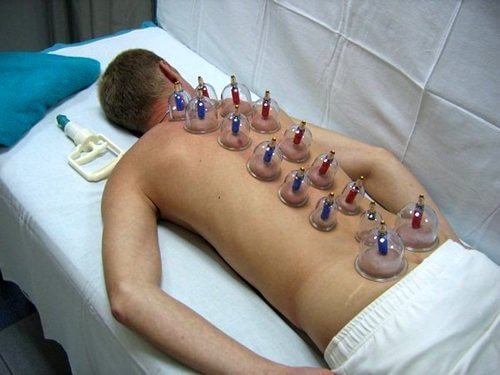
Vacuum cups on the back help quickly relieve spasms and pinching
Manual therapy
Treatment with a chiropractor will help unblock the pinching and realign the displaced vertebrae. To influence the deep layers of skin and muscles, the doctor uses pressure, twisting, and stretching techniques, which are prescribed to restore the mobility of the spinal column, eliminate muscle spasms and inhibit degenerative processes.
After completing a course of manual therapy, the patient is not bothered by pain, posture and back mobility improve.
Interesting article in continuation:
THE WHOLE TRUTH about manual therapy of the spine: what it is, techniques, indications and contraindications, reviews
Acupuncture
An alternative technique based on influencing biological active points is used as an additional method to the main therapy in order to achieve complete recovery. Thin needles are inserted at varying depths for a period of 20 to 40 minutes.
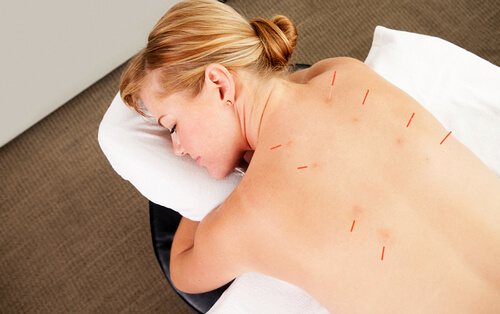
Acupuncture in skillful hands can help after just a few procedures
After the manipulation, the patient notes ease of movement of the body, absence of pain, and restoration of vitality. Acupuncture improves metabolic processes, eases the load on the vertebrae, and triggers the processes of restoration of cartilage tissue in the vertebral segments.
Spinal traction
A common method for relieving back pain is traction therapy. It is based on a procedure to stretch the vertebrae to increase the distance between them. The main purpose of this method is to eliminate the clamping of the nerve root in order to stabilize the patient’s condition.
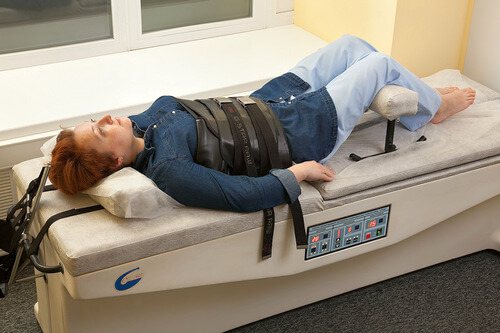
How is spinal traction performed?
Spinal traction can be considered an emergency aid to relieve an acute pain attack. During manipulation, spasmed muscles relax and lengthen, which relieves tension, improves blood circulation and cell nutrition.
Be sure to read this good article:
Spinal traction: what is it, harm and benefit, price, types (dry, hardware)
Belts and orthopedic corsets
During treatment, the spine should not be under stress. Orthopedic devices for the back provide support and relief of the vertebrae and create therapeutic compression to reduce pain. Corrective products can be used at different stages of the disease.
Corsets are designs with metal inserts. The belts are made from animal hair (dog, llama, camel) and are used when a warming effect is needed. Corset-type orthopedic products are found in different lengths: for the entire back - for the treatment of pinching in the lumbar and thoracic region, lumbosacral corset - when the focus is in the lower back.
When choosing a corset, you should take into account that the stronger the pain, the more rigid the characteristics of the orthopedic product.
If the neck is affected, a rigid neck brace (Philadelphia) or a Shants collar is prescribed, which provides moderate fixation of the neck. For patients with a pinched cervical nerve, it is recommended to rest at night on an orthopedic pillow, which is selected taking into account the length of the shoulder girdle and the patient’s weight.
How to treat at home with folk remedies
As part of auxiliary and distractive therapy, it is possible to use products from natural ingredients, which are prepared according to the recipes of traditional healers. The most commonly used are homemade ointments and healing baths with decoctions of medicinal herbs:
- hop;
- burdock;
- oregano;
- currant leaves;
- horsetail
Despite their natural origin, some of them can lead to allergic reactions. Therefore, before use, you need to consult a doctor about the composition and whether it is possible to take a bath if pinched.
Effective exercises
To restore mobility to the back and strengthen the muscular corset of the back, the doctor prescribes exercise therapy sessions. Taking into account age, area of pinching and concomitant pathologies, therapeutic exercises are individually selected for the patient.
Movements are performed smoothly, at a slow pace. At the first classes, there is an instructor who monitors the technique and compliance with the therapeutic load. Subsequently, the complex is regularly performed at home.
Video: exercise for a pinched spinal nerve
Prognosis and prevention
Timely treatment of radicular syndrome usually ends in recovery. However, with advanced forms of the disease, it can become chronic.
This course of pathology leads to gradual degenerative damage to all surrounding tissues. The functions of the spine and associated limbs are severely limited. The consequence of this may be the onset of disability.
In order to prevent the symptoms of radicular syndrome from manifesting themselves again, a number of restorative and preventive measures are required. It is necessary to constantly take medications that help normalize the activity of the nerve of the back and the cartilage tissue surrounding it, therapeutic exercises, swimming, balneology, wearing a corset, careful weight control, and spa treatment.
All these measures should be carefully and strictly observed, since neglect of the doctor’s instructions can cause a relapse of the disease.
Surgical treatment
When the pinching is caused by a vertebral deformity, large osteophytes or a large hernia, the cause can only be eliminated surgically. The most common procedure is microdiscectomy, during which the affected tissue is removed. If the nerve trunk is ruptured during the course of the disease, recovery is possible during a neurosurgical operation. After surgical treatment, the patient undergoes rehabilitation, which lasts from 2 weeks to 3 months.
Video: pinched nerve in the back (in the thoracic, lumbar, cervical spine): symptoms and treatment
Most often, back pain is a symptom of spinal diseases. When visiting a doctor, a pinched nerve in the back is detected, which can be caused by compression of the spinal cord root by a deformed vertebra or hernia.
The cause of intense pain in the lower back and leg can be compression of the sciatic nerve by the piriformis muscle. The exact origin of the unpleasant symptom is established during diagnosis, which is necessary for choosing treatment tactics. For a speedy recovery of the patient, complex therapy includes medications, massage and exercise therapy at home.
